Biology and Health Science Research
Biology and Health Science Research
May 2024 - May 2025
Analysis of cell death and inflammatory pathway connections induced by distinct clinical
isolates of Group B Streptococcus
Emilie Poirier
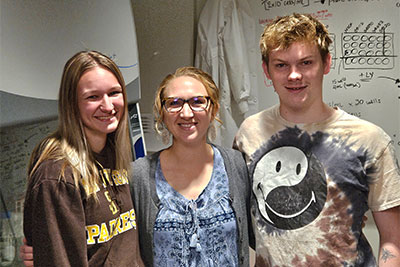 Group B Streptococcus (GBS) is an opportunistic pathogen normally found in the bacterial
flora of our gastrointestinal and reproductive tracts. It is known to cause serious
complications in pregnancy and illness in neonates. Identifying biological targets
that can effectively minimize the effects of GBS infection is the first step in developing
drugs that can treat GBS disease. Based on prior findings identified by Dr. Flaherty,
other student researchers at Aquinas, and other research groups, the goal of this
research is to identify connections between GBS-induced responses in macrophages.
We hope to determine whether previously identified pathways are part of a single connected
response or if they represent distinct responses to infection. The pathways we intend
to explore include the PI3K-Akt pathway, which regulates cell survival and death,
phagocytosis regulation, the NF kappa B and stress-responsive MAPK pathways which
regulate cellular responses pertaining to cell death and inflammatory signaling, and
the JAK-STAT pathway which regulates gene expression pertaining to inflammatory cell
activation. We hope to find any possible connections between these pathways, as well
as identifying the proteins involved in these connections. We anticipate that this
work will provide useful information for drug development.
Group B Streptococcus (GBS) is an opportunistic pathogen normally found in the bacterial
flora of our gastrointestinal and reproductive tracts. It is known to cause serious
complications in pregnancy and illness in neonates. Identifying biological targets
that can effectively minimize the effects of GBS infection is the first step in developing
drugs that can treat GBS disease. Based on prior findings identified by Dr. Flaherty,
other student researchers at Aquinas, and other research groups, the goal of this
research is to identify connections between GBS-induced responses in macrophages.
We hope to determine whether previously identified pathways are part of a single connected
response or if they represent distinct responses to infection. The pathways we intend
to explore include the PI3K-Akt pathway, which regulates cell survival and death,
phagocytosis regulation, the NF kappa B and stress-responsive MAPK pathways which
regulate cellular responses pertaining to cell death and inflammatory signaling, and
the JAK-STAT pathway which regulates gene expression pertaining to inflammatory cell
activation. We hope to find any possible connections between these pathways, as well
as identifying the proteins involved in these connections. We anticipate that this
work will provide useful information for drug development.
Faculty Advisor: Dr. Rebecca Flaherty, Biology & Health Science
Funded by: Mohler-Thompson Summer Research Grant
Comparison of JAK-STAT pathway activation induced by distinct clinical isolates of
Group B Streptococcus.
Daniel Austin
 Group B Streptococcus (GBS) is a bacterial pathogen that can cause complications for
mothers and their children, both during pregnancy and after birth, such as preterm
birth, pneumonia, and meningitis. The objective of this project is to clarify information
about the GBS-induced activation of the JAK-STAT pathway, which is an important immune
system regulatory pathway. We will investigate differential activation of the JAK-STAT
pathway in response to different strains of GBS that vary in virulence. We will continue
research initiated by former BMB student, Victoria Faber, by identifying and quantifying
active forms of JAK-STAT pathway members in GBS-infected macrophages. In addition,
we hope to identify connections between the JAK-STAT pathway and varying protein kinases
involved in inflammation and cell death. To complete these tasks we will utilize microbiology
and molecular biology methods such as Western Blotting, immunofluorescence microscopy,
and ELISA. We anticipate that this project will provide useful information regarding
the physiological influence of GBS infection on JAK-STAT signaling.
Group B Streptococcus (GBS) is a bacterial pathogen that can cause complications for
mothers and their children, both during pregnancy and after birth, such as preterm
birth, pneumonia, and meningitis. The objective of this project is to clarify information
about the GBS-induced activation of the JAK-STAT pathway, which is an important immune
system regulatory pathway. We will investigate differential activation of the JAK-STAT
pathway in response to different strains of GBS that vary in virulence. We will continue
research initiated by former BMB student, Victoria Faber, by identifying and quantifying
active forms of JAK-STAT pathway members in GBS-infected macrophages. In addition,
we hope to identify connections between the JAK-STAT pathway and varying protein kinases
involved in inflammation and cell death. To complete these tasks we will utilize microbiology
and molecular biology methods such as Western Blotting, immunofluorescence microscopy,
and ELISA. We anticipate that this project will provide useful information regarding
the physiological influence of GBS infection on JAK-STAT signaling.
Faculty Advisor: Dr. Rebecca Flaherty, Biology & Health Science
Funded by: Mohler-Thompson Summer Research Grant
Jessica Kean
Faculty Advisor: Dr. Robb Bajema
Investigating the Toxic Effects of Mineral and Chemical UV Filters on Coral Reef Ecosystems:
Debunking the Current Reef-Safe Standards
Insignis Honors Capstone
Healthy coral reefs provide survival and thriving grounds for a myriad of aquatic species, including commercially harvested fish species. Many marine biota exhibit diverse patterns in their association with coral reefs, making them a mandatory source of food and habitat. It has become apparent that ultraviolet (UV) filters used in the production of sunscreens and other cosmetics are known causative agents to harm coral reef ecosystems. These compounds enter the environment of the coral through increased tourism and wastewater and have been found to harm a wide variety of marine and freshwater species. Mineral (i.e. zinc oxide) and chemical (i.e. oxybenzone) UV filters are identified as having adverse effects on the symbiotic microalgae (zooxanthellae) associated with coral, resulting in coral bleaching. Current studies show that zinc oxide (ZnO) contributes more to coral bleaching than chemical filters by causing greater damage to zooxanthellae. At present, ZnO is still marketed as a reef-safe active ingredient in commercial sunscreens, despite its stronger correlation to zooxanthellae degradation. Considering the critical role coral reef ecosystems uphold in the sustaining of biodiverse wildlife, the prevention of their deterioration should be of utmost concern, from high levels of government to the average consumer.
Jessica Kean, Michelle Thompson, Joshua Wierenga
Faculty Advisor: Dr. Rebecca Flaherty
Identifying Mechanisms of Cell Death in Keratinocytes and Macrophages in Response
to Diverse Group B. Streptococcus Isolates
Mohler-Thompson Summer Research Program
Group B Streptococcus is an opportunistic bacterial pathogen that is most well-known for its ability to cause serious pregnancy complications and life-threatening infections in neonates. However, this pathogen is gaining increasing recognition as a major causative agent for skin and soft tissue infections, especially among immunocompromised individuals. We plan to explore GBS-mediated cell death in two important cell types that are both present in human skin, keratinocytes (HaCaT cells) and macrophages (differentiated THP-1 cells). Keratinocytes are the most abundant cell type in the epidermis, responsible for producing keratin. Macrophages are present throughout the body, initiating immune response to pathogens such as bacteria. We discovered that both caspase-dependent and independent forms of cell death are likely contributors to keratinocyte and macrophage cell death. Pertaining to HaCaT cells, ST types ST12 and ST1 seemed to be most virulent and therefore could be associated with more severe disease in skin and soft-tissue infection. Similarly, ST types ST17 and ST19 are likely to have shown more virulence concerning THP-1 cells. We are hopeful that this work will provide insights into how GBS leads to severe infections in the skin and why some strains tend to be more dangerous than others.
May 2023 - May 2024
Molecular interaction in Cnidarian Dinoflagellate Symbiosis
Ernesto Lopez
Alyssa Detweiler
We will use Aiptasia, a species of sea anemone that serves as a model for studying the invertebrate animals that are reef building corals. Aiptasia forms a symbiotic relationship with photosynthetic dinoflagellate algae (Symbiodinium) that is crucial for the survival of the anemone or coral as the disruption of this symbiosis leads to bleaching and potentially the host’s death. However, little is known about how these organisms interact with each other at a cellular and molecular level. Our goal is to help characterize some of the molecules that mediate this symbiosis. We are particularly interested in the function of scavenger receptor B class member 1 (SRB1). Notably, SRB1 is known to mediate host-parasite interactions during malaria infection and this protein is dramatically upregulated following the establishment of cnidarian-dinoflagellate symbiosis.
Faculty Advisor: Dr. L. Rob Peters, Biology
Funded by: Mohler-Thompson Summer Research Grant
Analysis of Keratinocyte and Macrophage Cell Death in Response to Diverse Group B
Streptococcus Isolates
Jessica Kean
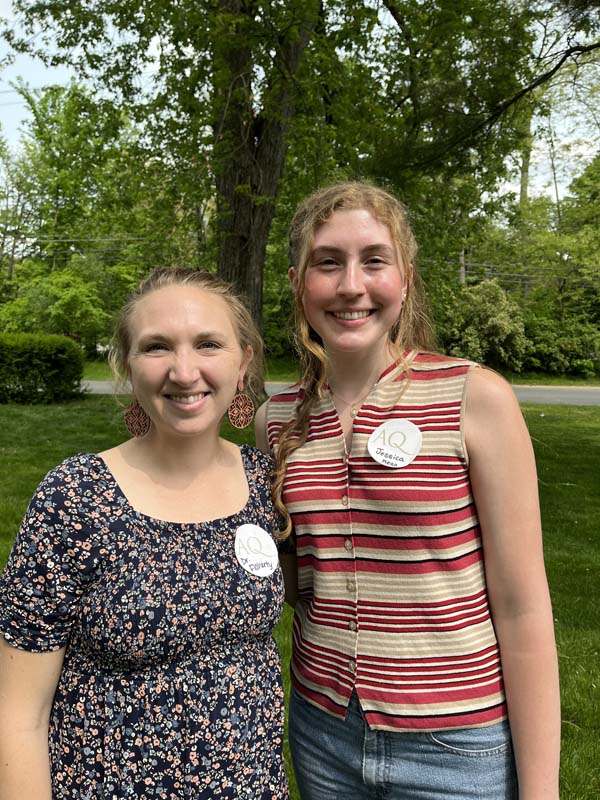 "Group B Streptococcus is an opportunistic bacterial pathogen that is most well-known
for its ability to cause serious pregnancy complications and life-threatening infections
in neonates. However, this pathogen is gaining increasing recognition as a major causative
agent for skin and soft tissue infections, especially among individuals with underlying
illnesses. While substantial steps have been taken to understand the mechanisms of
infection GBS employs during pregnancy and neonatal complications, much less is known
about its ability to cause infections in the skin and soft tissues. To address this
knowledge gap, we plan to explore GBS-mediated cell death in two important cell types
that are both present in human skin, keratinocytes and macrophages. We plan to use
these cells to first quantify the extent to which GBS induces cell death over time,
and then to identify the mechanism by which GBS-induced cell death occurs. Additionally,
we will compare human cell responses to four different strains of GBS, as GBS strains
with different sequence and capsule types vary in virulence. We are hopeful that this
work will provide insights into how GBS leads to severe infections in the skin and
why some strains tend to be more dangerous than others."
"Group B Streptococcus is an opportunistic bacterial pathogen that is most well-known
for its ability to cause serious pregnancy complications and life-threatening infections
in neonates. However, this pathogen is gaining increasing recognition as a major causative
agent for skin and soft tissue infections, especially among individuals with underlying
illnesses. While substantial steps have been taken to understand the mechanisms of
infection GBS employs during pregnancy and neonatal complications, much less is known
about its ability to cause infections in the skin and soft tissues. To address this
knowledge gap, we plan to explore GBS-mediated cell death in two important cell types
that are both present in human skin, keratinocytes and macrophages. We plan to use
these cells to first quantify the extent to which GBS induces cell death over time,
and then to identify the mechanism by which GBS-induced cell death occurs. Additionally,
we will compare human cell responses to four different strains of GBS, as GBS strains
with different sequence and capsule types vary in virulence. We are hopeful that this
work will provide insights into how GBS leads to severe infections in the skin and
why some strains tend to be more dangerous than others."
Faculty Advisor: Dr. Rebecca Flaherty, Biology
Funded by: Mohler-Thompson Summer Research Grant
May 2022 - May 2023
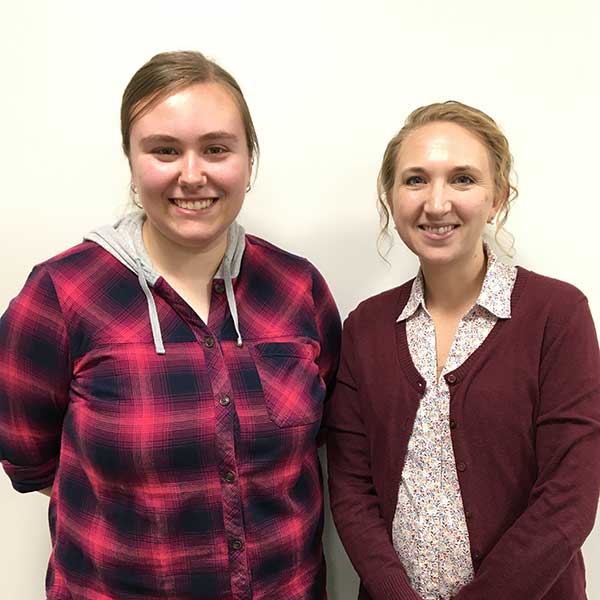
Analysis of Macrophage Cell Death in Response to Diverse Group B Streptococcus Isolates
Michelle Thompson
Group B Streptococcus (GBS) is a leading cause of preterm birth, stillbirth, and neonatal sepsis and meningitis worldwide [1–3]. It is a common resident of the genitourinary tract in approximately 40% of pregnant women and is a risk factor for preterm birth and neonatal disease [1–3]. In order to develop effective treatment and diagnostic strategies, there is a critical need to understand how GBS interacts with human tissues to induce inflammation, invade the extraplacental membranes, and harm the fetus or newborn. Macrophages are a key immune system cell type that play critical roles at the maternal-fetal interface during pregnancy as well as in the immune system of newborn infants. Our lab and others have previously identified differences in macrophage cell death in response to different GBS strains of varying virulence [4-5]. A key goal of this project will be to explore the type of cell death that is being induced in these macrophages following GBS infection with these diverse strains and to explore some of the macrophage signaling pathways that regulate these responses.
Faculty Advisor: Dr. Rebecca Flaherty
Funded by: Mohler-Thompson Summer Research Grant
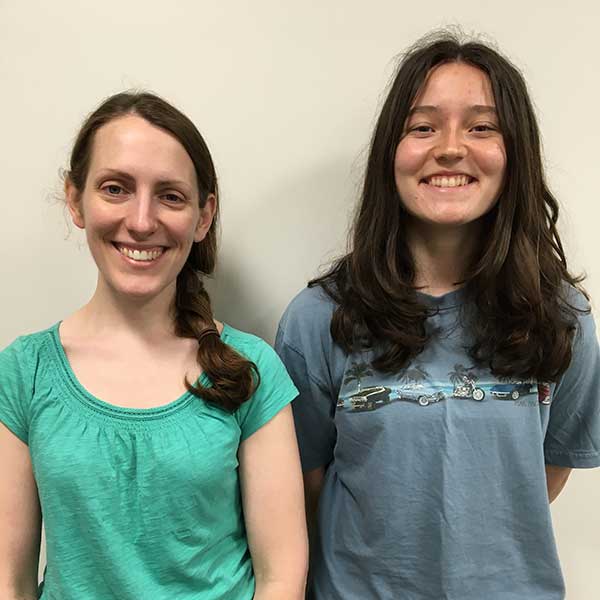
Influence of pollen aperture number on germination and pollen tube length in Thalictrum
dasycarpum, an in vivo study with fluorescence microscopy
Sydney Shenk
We will be continuing a line of past research to assess the influence of pollen aperture number on germination likelihood and timing and pollen tube length in Thalictrum dasycarpum, a wind-pollinated species. Using plants cultivated within the Aquinas College greenhouse, we plan to develop methods for fluorescence microscopy to observe pollen germination in vivo and to optimize our in vitro pollen-germination method for this species. We will also investigate the following parallel questions: What is the influence of stigmatic pollen load on pollen germination rate? How reliable are standard methods in determining actual pollen loads (i.e., how much pollen is lost in processing?)? Given time and methodological success, we will consider the influence of pollen load on the relative success of different pollen aperture morphs.
May 2021 - May 2022
Understanding the Role of the PI3K-Akt Pathway in the Macrophage Response to Group
B Streptococcus (GBS)
Yadira DeLeon-Lopez
Group B Streptococcus (GBS) can be part of a healthy individuals' microbial flora. However, problems may arise when a mother, who is colonized with GBS, becomes pregnant. As the fetus develops within the colonized mother, severe GBS infections may occur due to the limited capabilities of the developing fetal immune response. This may lead to the fetus becoming ill with meningitis, pneumonia, or sepsis, which may lead to death. The goal of this project is to understand how GBS manipulates cell signaling within macrophages in order to survive and cause disease. Specifically, we will investigate whether the PI3K/Akt pathway plays a role in three key aspects of the macrophage response to GBS infection. Our first aim will investigate why certain strains of GBS are engulfed by macrophages more rapidly than others. Next, we will evaluate how certain GBS strains survive more successfully within macrophages following phagocytosis. Lastly, we will compare the rate of survival of the macrophages themselves following infection with the different GBS strains. Our primary methods of analysis will include Western Blotting, fluorescence microscopy, and colony counting assays. This research may provide new insights for the development of diagnostic and therapeutic tools to combat GBS.
Faculty Advisor: Rebecca Flaherty
Funded by: Mohler-Thompson Summer Research Grant
Influence of aperture number on pollen grain viability and germination in Thalictrum
dasycarpum
Flore Bouyac
Pollen heteromorphism, the presence of multiple types of fertile pollen grains within all individuals of a population, is ubiquitous in the flowering-plant genus Thalictrum. Our aim is to investigate the selective regime influencing pollen-grain aperture number and whether this pattern differs among species/modes of pollination. We will observe pollen germination in vitro to measure aperture-number variation and timing and likelihood of germination within and among individuals of a wind-pollinated species, Thalictrum dasycarpum. Comparing our results to previous work on the insect-pollinated T. thalictroides, will bring us closer to both a universal understanding of the influence of aperture number on pollen grain fitness as well as how that relationship is altered by evolution in the mode of pollen transmission. Further, this study will provide insight into the evolution and maintenance of pollen heteromorphism.
Faculty Advisor: Rebecca Humphrey
Funded by: Mohler-Thompson Summer Research Grant
May 2020 - May 2021
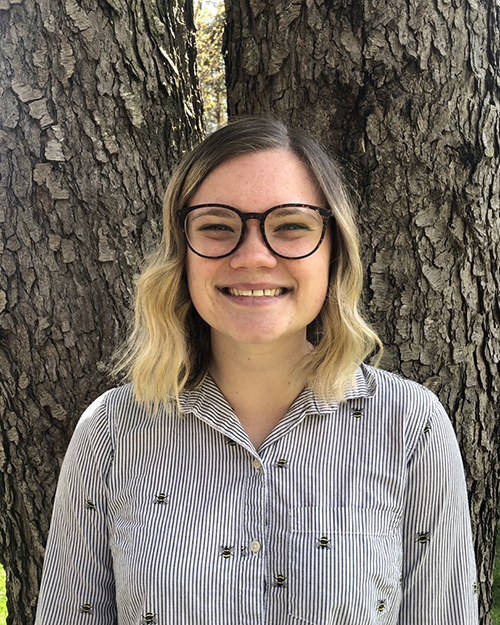
Influence of pollination mode on stigmatic pollen loads in Thalictrum
Teegan Galdeen
Each pollen grain is a multicellular individual upon which environmental selective pressures may act. One environment experienced by all pollen grains is the size of the stigmatic pollen load, which is assumed to differ between wind- and insect-pollinated species. To determine how pollination mode is related to the selective pressures experienced by individual grains, we will analyze previously collected data on pollen loads in wind- and insect-pollinated Thalictrum species. Specifically, we will test the hypothesis that stigmatic pollen loads in insect-pollinated species are significantly higher than in wind-pollinated Thalictrum species. We plan to write a manuscript about this project for submission to a peer-reviewed publication. We will also be studying R programming, light- and fluorescence-microscopy techniques, and in vivo pollen staining protocols.
Faculty Advisor: Dr. Rebecca Humphrey
Funded by: Mohler-Thompson Summer Research Grant
Investigation of coral-dinoflagellate symbiosis - literature review (if we get access
to lab, we will use the Aiptasia model system)
Lucas Topie
We will review the existing literature to identify proteins suspected to be involved in coral-dinoflagellate symbiosis, with a particular focus on innate immune receptors expressed by the coral host. We will focus on cnidarian host proteins that may mediate recognition and/or uptake of the dinoflagellate by the coral host. If we have access to the lab later in the summer, we plan to isolate cDNA coding for proteins of interest from Aiptasia (a model cnidarian) and clone these genes into suitable expression vectors. We will write a review of research published on the recognition and uptake of dinoflagellates by the coral host with a focus on work published since the 2012 review by Davy et al "Cell Biology of Cnidarian-Dinoflagellate Symbiosis"
Faculty Advisor: Larry Robert Peters PhD
Funded by: Mohler-Thompson Summer Research Grant
May 2019 - May 2020
Constructing tools to study the role of an innate immune receptor (Nod1) in hematopoietic
stem cell development
Svetlana Djirackor and Lucas Topie
We will subclone zebrafish dominant negative Nod1 alleles our group formerly designed. These subcloned alleles will be used by our collaborators to advance hematopoietic stem cell research. The zebrafish model was chosen due to its ease of use in large-scale applications, chemical screens and in vivo imaging.
Faculty Advisor: L. Rob Peters
Funded by: Mohler-Thompson Summer Research Grant
Relationship between pollen aperture number and germination in Thalictrum
Spencer Graham
Pollen heteromorphism is a characteristic belonging to certain species of plants in which an individual produces multiple types of fertile pollen grains. It is possible that certain pollen morphs are inherently more viable than others. We would like to observe pollen germination in vitro in order to measure morphological variation and efficiency of germination within and among individuals of multiple populations and species of Thalictrum. This study will provide insight into the evolution of pollen heteromorphism.
Faculty Advisor: Rebecca Penny Humphrey
Funded by: Mohler-Thompson Summer Research Grant
The Dessication Tolerance of Craterostigma plantagineum
Michael Kalinowski
We studied the genetic basis of the dehydration tolerance of Craterostigma plantagineum, a small plant from South Africa. We utilized RNA-seq to trace RNA expression of the leaf and root tissues as the plant went through the desiccation cycle, and rehydrated. This work was mainly exploratory in nature, as this plant has never before been examined in this way.
Faculty Advisor: Robert VanBuren, Michigan State University
Funded by: NSF-funded
May 2018 - May 2019
Bringing Biodiversity to Restored Grasslands
Dana VanHuis
Our project focuses on grassland management. We are looking at five different grasslands (four at PCCI and one in Grand Rapids). Each grassland is either being burned, mowed, or left un-managed. We are then studying the biodiversity indexes of birds, insects, and vegetation in each of these fields to determine which management technique fosters the greatest levels of biodiversity. Hopefully through this study, a model can be made for other organizations and landowners that can be used to move restored grasslands from tallgrass monocultures to diverse and thriving grasslands.
Faculty Advisor: Dr. Rob Keys, Cornerstone University
Funded by: Pierce Cedar Creek Institute
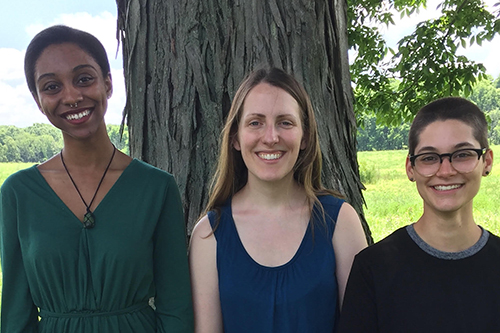 Abiotic factors affecting prevalence of Rosa multiflora in Southwest Michigan
Abiotic factors affecting prevalence of Rosa multiflora in Southwest Michigan
Alyssa Wilson and Stephanie Clark
Rosa multiflora, or multiflora rose, is an invasive plant species in the northeast and midwest United States. We are interested in quantifying the abiotic factors--such as soil pH and moisture, distance from trail, and sunlight availability--that contribute to the ability of multiflora rose to proliferate in some areas over others.
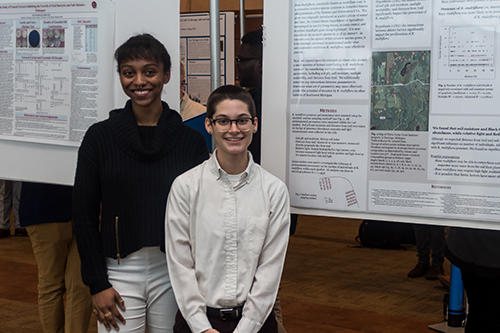 The goal of this research is to provide land managers with information regarding which
areas are most susceptible to multiflora rose invasion and establishment, specifically
in Southwest Michigan.
The goal of this research is to provide land managers with information regarding which
areas are most susceptible to multiflora rose invasion and establishment, specifically
in Southwest Michigan.
Faculty Advisor: Dr. Rebecca Humphrey
Funded by: Pierce Cedar Creek Institute
Investigating the Antibacterial Properties of Natural Substances
Gina Nowland
We will research natural antimicrobial substances and previously isolated soil bacteria. Previous research on natural antimicrobial substances indicated that allicin, a compound created from garlic when it is crushed, and eugenol, a compound from clove oil, are highly effective against bacteria such as Streptococcus mutans. An oral bacterium, S. mutans, is an organism that contributes to the formation of plaque and tooth decay. The growth and growth inhibition of S. mutans on mitis salivarius (MS) agar is being studied under aerobic and anaerobic conditions.
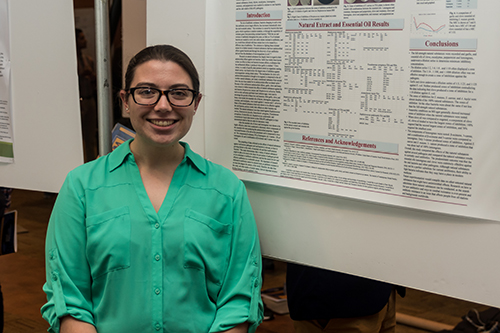 These conditions were put in place to replicate the growth of oral bacteria at night.
The mouth, being closed, may decrease the amount of oxygen present to the bacteria
making anaerobic conditions ideal to test how the growth of bacteria such as S. mutans
could be affected. Individual bacteria isolated from soil samples collected during
September 2017 will continue to be characterized and tested against ESKAPE pathogen
safe relatives in the search for new antibiotics. Many of these bacterial isolates
were previously found to be highly effective in inhibiting the growth of the ESKAPE
pathogens.
These conditions were put in place to replicate the growth of oral bacteria at night.
The mouth, being closed, may decrease the amount of oxygen present to the bacteria
making anaerobic conditions ideal to test how the growth of bacteria such as S. mutans
could be affected. Individual bacteria isolated from soil samples collected during
September 2017 will continue to be characterized and tested against ESKAPE pathogen
safe relatives in the search for new antibiotics. Many of these bacterial isolates
were previously found to be highly effective in inhibiting the growth of the ESKAPE
pathogens.
May 2017 - May 2018
Utilizing the Gateway cloning technique for creation of Tol2 transposons containing
wild type and mutant zebrafish NOD1 alleles.
Benjamin Arnson
NOD1 is an innate immune receptor involved in detecting cytosolic bacteria. We plan to subclone wild type (wt) and mutant (K202R) zebrafish NOD1 alleles into the plasmid pENTR1ADS. This will allow use of a Gateway cloning technique to make three different Tol2 transposons encoding the wt, K202R and L36Q NOD1 alleles, respectively. These transposons will allow our collaborators to make transgenic zebrafish in which NOD1 function can be controlled in a tissue-specific manner. The transgenic zebrafish will then be used to study the role of NOD1 in hematopoiesis (i.e., the development of blood cells).
Faculty Advisor: Dr. Rob Peters
Funded by: Mohler-Thompson Summer Research Grant
Design of the Riparian Buffer along Coldbrook Creek at Brookby Estate
Amanda Roth
Riparian buffers are areas of vegetation along the edge of water bodies; they provide protection for water bodies and habitat for organisms. The goal of this research project is to create an aesthetically pleasing buffer along Coldbrook Creek at the Brookby Estate to preserve the estate’s historic integrity while improving its environmental value. This project involves researching wildflower species that will thrive along the creek, growing these plants from seed, and installing them along the creek. Different plant propagation methods will be investigated to determine the best method for building a riparian buffer from seed.
Faculty Advisor: Dr. Rebecca Humphrey
Funded by: Mohler-Thompson Summer Research Grant
May 2016 - May 2017
Faculty Advisor: Dr. Jennifer Hess
Funded by: Mohler-Thompson Summer Research Grant
The Characterization of Bacteria Contaminants in Vitamins and Supplements
Avery Wagner
A previous Mohler Thompson student found that a particular brand of garlic capsule
was contaminated while testing its antimicrobial effects against a common bacteria
found in dental plaque. We will attempt to characterize this contaminant through various
staining techniques, selective and differential media tests, and some molecular biology.
We will also test other vitamins and supplements for contaminants, including a new
batch of the same brand of garlic capsule that had contaminants four years ago.
Faculty Advisor: Jennifer Hess
Funded by: Mohler-Thompson Summer Research Grant
Understanding the Endosymbiotic Relationship of Corals
Bridgette Degenhardt
This summer we will be studying the different genes involved in the endosymbiotic relationship between the anemone Aiptasia and the algae that live within it. Variables such as temperature, bleaching, and pH can be manipulated so that we may attempt to explore the different genetic responses within Aiptasia using qPCR. We hope to clone certain genes of interest into bacterial plasmids and eventually characterize their proteins to better understand the molecular and chemical relationship between corals and their endosymbionts.
Faculty Advisor: LR Peters
Funded by: Mohler-Thompson Summer Research Grant